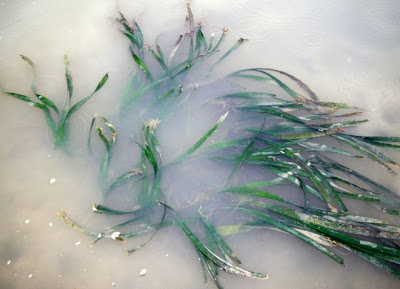After checking out the natural reefs of St John's Island with a special focus on anemones, we had to hide in the shelter for a while due to the bad weather. Good thing was that the rain became a drizzle and I spent the remaining time of the low tide period exploring a new part of St John's shore.
As you can see here, this part is just beside the jetty. Usually, we would just explore the sandy lagoon at the other side of the jetty and its reef beyond but this particular spot is probably much more neglected. In fact, Daniel spent some time on this shore during February and he found cowries and hairy crabs. They are also many corals as well!
I checked out some of the rocks there and was plesantly surprised to find a crevice with a pair of Marine spiders (Desis martensi) inhabitating within it. Yes, during high tide, marine spiders hide in air pockets among crevices of submerged rocks.
What is interesting is what looks like the webs created by the marine spider!
Like Daniel's find, I also had an encounter with a hairy crab (Family Pilumnidae). These hairy and furry looking crab is sometimes also known as the teddy bear crab since it looks cuddly.
Seagrass wise, I saw a clump of the tape seagrass (Enhalus acoroides).
But what is really surprising of this shore is the vast extent of densely packed colonies of Montipora corals (Montipora sp.).
And they stretch all the way out to the low water level mark!
This is a closer look of the Montipora corals. Probably someone can help me with the coral id.
Among the branching corals, life exists just like this banded fan worm. I believe there are other life among the corals but I didn't have the luxury of time to look around more. Probably some seahorses are lurking around? Hehe.
Lastly, I checked out the sandy lagoon at the other side of the jetty.
This sandy lagoon is home to many Common sea stars (Archaster typicus) that are unfortunately already badly wiped out at mainland shores.
The rockier parts are quite colourful with an assortment of seaweed, zoanthids, sponges and ascidians.
Attaching onto rocks are snails like this Spotted top shell snail (Trochus maculatus). Though from the top it looks quite well camouflaged to the surrounding with its encrusting lifeforms, the underside shows pretty patterns. For this snail, its operculum is thin and slightly yellowish in colour.
Though it is a sandy lagoon, there are still some colonies of hard corals that had colonized the area. This is heartening.
Like our northern sandy and seagrassy shores, one can also find the Spotted moon crab (Ashtoret lunaris).
It was only until this trip that I noticed the presence of five spots on their carapace.
This is a pretty bivalve shell that I've also found on the lagoon. However, it is dead. I hope to find an alive one soon!
Prowling among the sand will be this Oval moon snail (Polinices mammatus). Mammatus means 'breast' in Latin. This is so because the overall shape resembles a breast with their spiral tip smoothly sticking out.
This shore is also home to a wide variety of Strombid conches!
The most common one probably is this Gong-gong or Pearl conch (Strombus canarium).
There are others like this with bit of brownish patterns on its white shell. I don't know exactly which species of conch this is.
But the most puzzling must these patterned conches that we started to see on intertidal shores since February this year. Firstly at Tanah Merah, then Changi, Pasir Ris, Lazarus and now St John's.
This is the underside of the above unknown conches. Chee Kong, Mei Lin and I are still working on the id of this conches so we hope for your patience in getting them identified properly.
I particularly like this one with yellowish-orange underside. It has a foot-like operculum that can flip itself right side up. What interests many first timers of the shores will be the two long eye-stalks peering at us.
A final comparison of the patterned conches with the common Gong gong at the bottom.
That's all for the St John's series! This coming week is low tide again and I'm looking forward to a couple more trips!
Saturday, July 18, 2009
Exploring a new part of St John's shore
Subscribe to:
Post Comments (Atom)



























1 comment:
Wow, what an amazing array of ocean species. The colors are amazing! So much different in tropical waters than much further north.
Wonderful, educational post, keep em coming.
Bill;wwww.wildramblings.com
Post a Comment